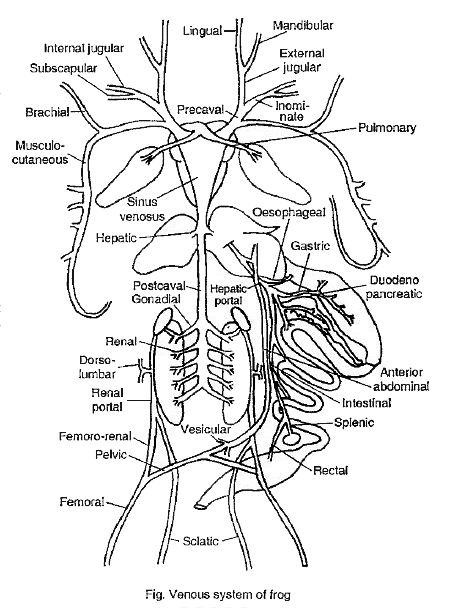Describe venous system of frog.
Text Solution
Venous System : It is the system concerned to collect blood from all parts of body. Venous system can be described in four parts :

I. Venae cavae
2. Veins of the hindlimbs
3. Veins from the alimentary canal
4. Pulmonary veins
1. Venae Cavae : Deoxygenated blood from the body is brought to the sinus venosus by the venae cavae. The two bring blood from the anterior part of the body and enter the sinus venous these are called anterior vanae cavae or precavals. The third returns blood from the posterior part of the body and joins the sinus venosus. This is called as posterior vena cava or postcaval.
(a) Precavals : Each precaval is formed
(i) external jugular (ii) Innominate (iii) Subclavian veins.
(i) External Jugular vein : It receives a lingual vein from the floor of the buccopharyngeal cavity and a mandibular vein from the lower jaw.
(ii) Innominate vein : It receives an internal jugular vein from the brain, eye etc. and asubscapularvein from the shoulder and back of the arm.
(iii) Subclavian vein : It is formed by brachial vein from the forelimb and musculocutaneous vein from the skin and muscles.
(b) Postcaval : The postcaval opens into the posterior angle of the sinus venosus. It receives the following veins.
(1) Renal veins : These are 5 or 6 pairs of short veins carrying blood from the kidneys into the postcaval.
(ii) Genital veins : These are a pair of short slender veins bringing blood from the gonads and opening into the postcaval just in front of the renal veins. They are called the spermatic veins in the male frog and the ovarian veins in the female frog.
(iii) Hepatic veins : These collect blood from the liver.
2. Veins from the hindliinbs : Blood from each hindlimb is collected by two veins the femoral from the outer side and the sciatic from the inner side. The femoral vein bifurcates into two-the pelvic vein on the inner side and the renal portal vein on the outer side. The renal portal vein gets the sciatic vein and then proceeds forward towards kidney. Dorso lumbar vein from the dorsolateral parts of the body wall and oviducal vein from the oviduct in the female. It then opens into the kidney where it breaks up into capillaries. Blood from the kidney is returned to the postcaval by renal veins.
The pelvic vein passes inward where it meets its fellow to form the anterior or ventral abdominal vein. The latter runsh forward. It receives a small median vesicular vein from the urinary bladder and several pairs of small veins from the abdominal muscles. It passes upwards and enters the liver.
3. Veins from the Alimentary canal : Hepatic portal vein collects blood from alimentary canal. Its main tributaries include oesophageal vein from oesophagus, gastric vein from the stomach, duodenopancreatic vein from the duodenum and pancreas, intestinal vein from the ileum, splenic vein from the spleen, and rectal or posterior mesenteric vein from the rectum.
The hepatic portal vein opens into liver. The.anterior abdominal and hepatic portal veins are joined together by protoabdominal vein.
4. Pulmonary Veins : The oxygenated blood from each Imig is returned by a pulmonary vein. The two pulmonary veins unite to form the common pulmonary vein which opens into the left auricle of the heart.
|
Similar Questions
Knowledge Check
The venous system of frog differs from that of rat in having
AHepatic veinBThree vena cavaeCRenal portal systemDHepatic portal systemThe venous system of frog differs from that of rabbit in having
AHepatic veinBTHree vena cavaeCRenal portal systemDHepatic portal systemThe nervous system of frog is organised ino
ACentral nervous system and peripheral nervous systemBCentral nervous system and autonomic nervous systemCCentral nervous system, peripheral nervous system and autonomic nervous systemDBrain and spinal cord
Describe the digestive system of frog.
View SolutionDescribe the manus or pes of frog.
View SolutionWhich statement is true about the venous blood vessels of frog?
View SolutionWhich statement is true about the venous blood vessels of frog
View SolutionWhich of the following special venous system is present in frog?
View Solution
